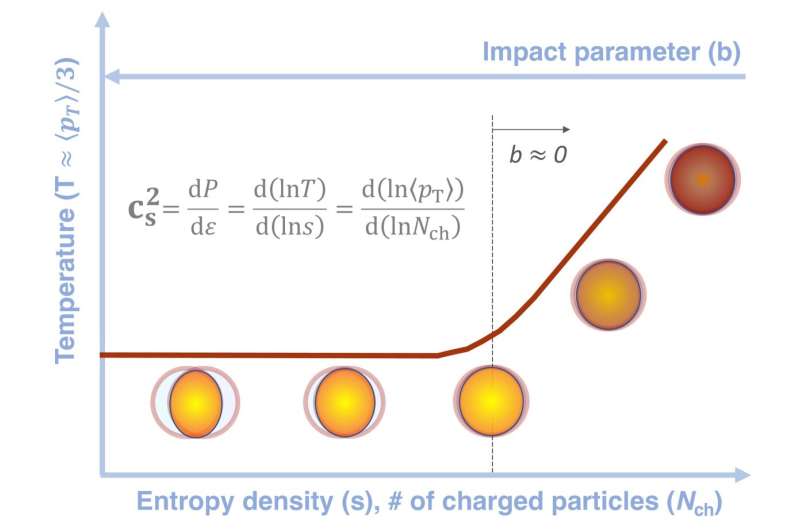This article has been reviewed according to Science X's editorial process and policies. Editors have highlighted the following attributes while ensuring the content's credibility:
fact-checked
preprint
trusted source
proofread
CERN researchers measure speed of sound in the quark–gluon plasma more precisely than ever before

Neutron stars in the universe, ultracold atomic gases in the laboratory, and the quark–gluon plasma created in collisions of atomic nuclei at the Large Hadron Collider (LHC): they may seem totally unrelated but, surprisingly enough, they have something in common. They are all a fluid-like state of matter made up of strongly interacting particles. Insights into the properties and behavior of any of these almost-perfect liquids may be key to understanding nature across scales that are orders of magnitude apart.
In a new paper, the CMS collaboration reports the most precise measurement to date of the speed at which sound travels in the quark–gluon plasma, offering new insights into this extremely hot state of matter.
Sound is a longitudinal wave that travels through a medium, producing compressions and rarefactions of matter in the same direction as its movement. The speed of sound depends on the medium's properties, such as its density and viscosity. It can, therefore, be used as a probe of the medium.
At the LHC, the quark–gluon plasma is formed in collisions between heavy ions. In these collisions, for a very small fraction of a second, an enormous amount of energy is deposited in a volume whose maximum size is that of the nucleus of an atom. Quarks and gluons emerging from the collision move freely within this area, providing a fluid-like state of matter whose collective dynamics and macroscopic properties are well described by theory.
The speed of sound in this environment can be obtained from the rate at which pressure changes in response to variations in energy density or, alternatively, from the rate at which temperature changes in response to variations in entropy, which is a measure of disorder in a system.
In heavy-ion collisions, the entropy can be inferred from the number of electrically charged particles emitted from the collisions. The temperature, on the other hand, can be deduced from the average transverse momentum (i.e., the momentum transverse to the collision axis) of those particles.
Using data from lead–lead collisions at an energy of 5.02 trillion electronvolts per pair of nucleons (protons or neutrons), the CMS collaboration has measured for the first time how the temperature varies with the entropy in central heavy-ion collisions, in which the ions collide head-on and overlap almost completely.
From this measurement, they obtained a value for the speed of sound in this medium that is nearly half the speed of light and has a record precision: in units of the speed of light, the squared speed of sound is 0.241, with a statistical uncertainty of 0.002 and a systematic uncertainty of 0.016. Using the mean transverse momentum, they also determined the effective temperature of the quark–gluon plasma to be 219 million electronvolts (MeV), with a systematic uncertainty of 8 MeV.
The results match the theoretical expectation and confirm that the quark–gluon plasma acts as a fluid made of particles that carry enormous amounts of energy.
The paper is published on the arXiv preprint server.
More information: Extracting the speed of sound in the strongly interacting matter created in ultrarelativistic lead-lead collisions at the LHC, arXiv (2024). DOI: 10.48550/arxiv.2401.06896
Journal information: arXiv
Provided by CERN





















